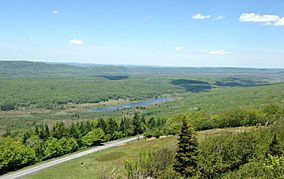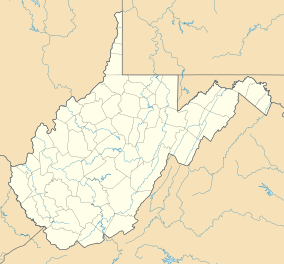Canaan Valley National Wildlife Refuge facts for kids
Quick facts for kids Canaan Valley National Wildlife Refuge |
|
|---|---|
|
IUCN Category IV (Habitat/Species Management Area)
|
|
 |
|
| Location | Tucker, West Virginia, United States |
| Area | 16,613.44 acres (67.2322 km2) |
| Elevation | 3,284 ft (1,001 m) |
| Established | July 11, 1994 |
| Website | Canaan Valley National Wildlife Refuge |
The Canaan Valley National Wildlife Refuge (CVNWR) is a special place in Tucker County, West Virginia. It was the 500th National Wildlife Refuge to be created in the United States. This refuge protects a unique valley with wetlands and high-up lands in the Allegheny Mountains. The U.S. Fish and Wildlife Service (USFWS) manages this important area.
Contents
History of Canaan Valley Refuge
People started wanting to protect Canaan Valley as a wildlife refuge way back in 1961. In the 1970s, groups that cared about nature worked hard to save the valley. They faced a big challenge from a company called Allegheny Power Systems (APS). This company owned a large part of Canaan Valley since 1923.
APS wanted to build a power plant that would use water to make electricity. This project would have flooded about a quarter of the valley. In 1977, APS got permission to build their power plant. But the next year, the U.S. Army Corps of Engineers said no. They stopped the project because it would harm the valley's wetlands. Protecting wetlands was a new idea at that time.
The idea for the Canaan Valley National Wildlife Refuge was first approved in 1979. APS tried to fight the decision in court, even going to the highest court, the Supreme Court. But in 1988, the Supreme Court decided not to hear their case. This meant the way was clear to create the refuge.
The refuge officially started on July 11, 1994, with the purchase of a small part of the valley. In 2002, a much larger section was bought from APS. More land has been added since then. Today, the refuge covers about 16,628 acres (67 km2). This is almost 70% of the entire valley, which is about 25,000 acres (100 km2).
Wildlife in Canaan Valley
The refuge has many different types of homes for animals. These include wet forests, bushy areas (shrublands), and open spaces. You can find many animals here.
Some common animals include:
You might also spot some shyer animals like:
Beaver dams are also common and help create new water areas. Many types of birds live here, including wild turkeys and ruffed grouse. The refuge is also very important for birds that are becoming rare in North America. These include the bobolink and the cerulean warbler. In the waters, you can find native brook trout and other types of trout and bass.
Things to Do and See
The Canaan Valley National Wildlife Refuge offers many fun activities. You can enjoy watching wildlife and taking pictures. Hunting and fishing are also allowed in certain areas.
You can also explore the refuge by:
- Hiking on 31 miles (50 km) of trails.
- Biking on 23 miles (37 km) of trails.
- Riding horses on 22 miles (35 km) of trails.
There are also 7 miles (11 km) of roads that you can drive on to access different parts of the refuge. The refuge also offers special programs to learn about nature and the environment.
Images for kids




